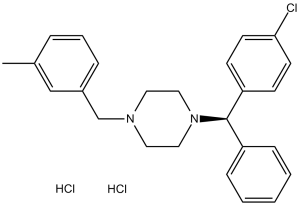This product is for research use only, not for human use. We do not sell to patients.

| Size | Price | Stock |
|---|---|---|
| 10g | $150 | Check With Us |
| 25g | $280 | Check With Us |
| 50g | $420 | Check With Us |
Cat #: V1216 CAS #: 1104-22-9 Purity ≥ 98%
Description: Meclizine 2HCl (Ru Vert M; Ru-Vert-M; RuVertM; NSC28728; NSC-28728), the dihydrochloride salt of meclizine, is a potent histamine H1 receptor antagonist used to treat nausea and motion sickness, and has anti-histamine, anti-muscarinic and anti-oxidative phosphorylation properties
Publications Citing InvivoChem Products
Product Promise

- Physicochemical and Storage Information
- Protocol
- Related Biological Data
- Stock Solution Preparation
- Quality Control Documentation
| Molecular Weight (MW) | 463.87 |
|---|---|
| Molecular Formula | C25H27Cl2N2.2HCl |
| CAS No. | 1104-22-9 |
| Storage | -20℃ for 3 years in powder formrr |
| -80℃ for 2 years in solvent | |
| Solubility In Vitro | DMSO: 4 mg/mL (8.6 mM)rr |
| Water: <1 mg/mLrr | |
| Ethanol: <1 mg/mL | |
| Solubility In Vivo | 5% DMSO+95% Corn oil: 10mg/mL |
| Synonyms | NSC 28728; Ru Vert M; Ru-Vert-M; RuVertM; NSC28728; NSC-28728; |
| Protocol | In Vivo | Meclizine (Meclozine; 10-100 mg/kg; ip) dihydrochloride protects mouse against kidney ischemia. Pretreatment with 100 mg/kg of Meclizine, 17 or 24 h prior to ischemia shows kidney protection in mice. Meclizine dihydrochloride reduces mitochondrial oxygen consumption by directly inhibiting the Kennedy pathway of phosphatidylethanolamine biosynthesis and up-regulated glycolysis |
|---|---|---|
| Animal model | Meclizine (Meclozine; 10-100 mg/kg; ip) dihydrochloride protects mouse against kidney ischemia. Pretreatment with 100 mg/kg of Meclizine, 17 or 24 h prior to ischemia shows kidney protection in mice. Meclizine dihydrochloride reduces mitochondrial oxygen consumption by directly inhibiting the Kennedy pathway of phosphatidylethanolamine biosynthesis and up-regulated glycolysis | |
| Dosages | 10, 30, 60 or 100 mg/kg | |
| Administration | Protected mice from kidney ischemia-reperfusion injury. |
| Solvent volume to be added | Mass (the weight of a compound) | |||
|---|---|---|---|---|
| Mother liquor concentration | 1mg | 5mg | 10mg | 20mg |
| 1mM | 2.1558 mL | 10.7789 mL | 21.5578 mL | 43.1155 mL |
| 5mM | 0.4312 mL | 2.1558 mL | 4.3116 mL | 8.6231 mL |
| 10mM | 0.2156 mL | 1.0779 mL | 2.1558 mL | 4.3116 mL |
| 20mM | 0.1078 mL | 0.5389 mL | 1.0779 mL | 2.1558 mL |
This equation is commonly abbreviated as: C1 V1 = C2 V2
- (1) Please be sure that the solution is clear before the addition of next solvent. Dissolution methods like vortex, ultrasound or warming and heat may be used to aid dissolving.
- (2) Be sure to add the solvent(s) in order.




































